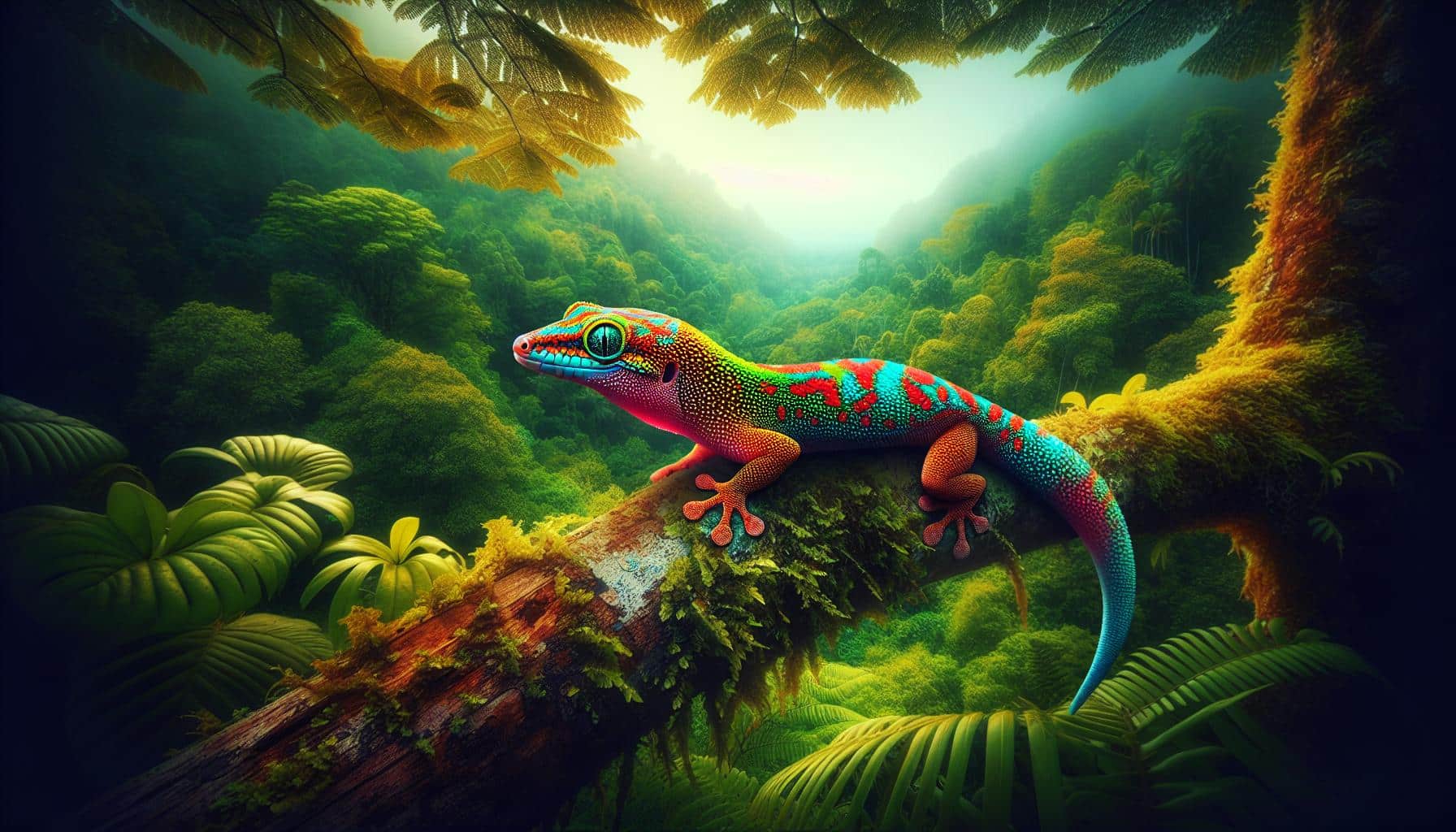Gekco: From Colorful Pets to Endangered Species
Have you ever marveled at a gecko’s ability to defy gravity? These fascinating creatures captivate with their unique adaptations and diverse species. From the tiny dwarf geckos to the impressive tokay geckos, these lizards have been enchanting humans for centuries.
Geckos are found on every continent except Antarctica, thriving in various habitats from rainforests to deserts. They’re known for their remarkable climbing abilities, thanks to specialized toe pads covered in microscopic hairs. This incredible feature allows them to scale smooth surfaces and even walk upside down on ceilings.
Key Takeaways
- Geckos are small to medium-sized lizards found worldwide, known for their unique adaptations and diverse species.
- Most geckos have specialized toe pads covered in microscopic hairs, allowing them to climb smooth surfaces and walk upside-down.
- Popular gecko types include the common house gecko, leopard gecko, and crested gecko, each with distinct characteristics.
- Geckos exhibit fascinating behaviors such as nocturnal activity, exceptional climbing abilities, and tail autotomy for defense.
- As pets, geckos require specific housing conditions, a diet of insects, and gentle handling, with proper care resulting in lifespans of 10-20 years.
What Is a Gecko?
Geckos are small to medium-sized lizards belonging to the family Gekkonidae. These reptiles are known for their unique physical features and adaptations that allow them to thrive in various environments worldwide.
Physical Characteristics
Geckos possess distinctive traits that set them apart from other lizards. Their bodies are typically flattened and covered in small, granular scales. Most geckos have large, lidless eyes with vertical pupils, enabling excellent night vision. Their toes are equipped with specialized adhesive pads covered in microscopic hairs called setae, allowing them to climb smooth surfaces and even walk upside down on ceilings.
Geckos range in size from the tiny 1.6 cm Sphaerodactylus ariasae to the 35 cm New Caledonian giant gecko. Their coloration varies widely, with some species displaying vibrant patterns and others exhibiting more muted tones for camouflage. Many geckos can change color to blend with their surroundings or regulate body temperature.
Natural Habitat
Geckos are found in diverse habitats across the globe, excluding Antarctica. They inhabit tropical and subtropical regions, including rainforests, deserts, and mountainous areas. Some species have adapted to urban environments, often seen on walls and ceilings of buildings in warm climates.
These adaptable reptiles occupy various ecological niches. Arboreal geckos live primarily in trees, while terrestrial species dwell on the ground. Some geckos have specialized adaptations for specific habitats, such as webbed feet for climbing on wet surfaces or fringed toes for traversing sandy desert terrain.
Types of Geckos
Geckos come in a diverse array of species, each with unique characteristics and adaptations. Here’s an overview of three popular gecko types:
Common House Gecko
Common house geckos (Hemidactylus frenatus) are small, nocturnal lizards found worldwide. They’re pale gray or translucent with dark spots and measure 3-6 inches long. These geckos thrive in urban environments, often seen on walls and ceilings of homes. They have specialized toe pads that allow them to climb smooth vertical surfaces effortlessly.
Leopard Gecko
Leopard geckos (Eublepharis macularius) are ground-dwelling reptiles native to arid regions of Asia. Adults typically reach 8-10 inches in length. They’re known for their distinctive spotted pattern, resembling a leopard’s coat. Unlike many gecko species, leopard geckos have eyelids and lack the adhesive toe pads. They’re popular pets due to their docile nature and relatively easy care requirements.
Crested Gecko
Crested geckos (Correlophus ciliatus) are arboreal lizards native to New Caledonia. They’re named for the crest-like fringes that run from their eyes to their tails. These geckos measure 6-10 inches long and come in various colors and patterns. Crested geckos have adhesive toe pads for climbing and a prehensile tail that helps them navigate through trees. They’re known for their calm temperament and are popular in the pet trade.
Gecko Behavior and Adaptations
Geckos exhibit fascinating behaviors and unique adaptations that enable them to thrive in diverse environments. These lizards have evolved specialized traits that contribute to their survival and success across various habitats.
Nocturnal Nature
Most gecko species are nocturnal, becoming active during nighttime hours. This adaptation allows geckos to avoid daytime predators and exploit food sources that are more abundant at night. Nocturnal geckos have:
- Large, sensitive eyes with vertical pupils that can dilate widely in low light conditions
- Highly developed night vision, enabling them to see in near-darkness
- Enhanced hearing capabilities to detect prey and predators in the dark
- Specialized skin pigments that allow for effective camouflage during daylight hours
Climbing Abilities
Geckos are renowned for their exceptional climbing skills, which are made possible by unique adaptations in their feet. These adaptations include:
- Microscopic setae on their toe pads, creating strong adhesive forces through van der Waals interactions
- The ability to climb smooth vertical surfaces, including glass and polished stone
- Rapid attachment and detachment of their feet, allowing for quick movement on various surfaces
- Specialized muscles and tendons that control the orientation of their toe pads for optimal adhesion
Tail Autotomy
Tail autotomy is a defensive mechanism employed by many gecko species. This adaptation involves:
- The ability to voluntarily detach their tail when threatened or grabbed by a predator
- A pre-scored fracture plane in the tail vertebrae that facilitates clean separation
- Rapid regeneration of a new tail, though it may differ in appearance and structure from the original
- The detached tail continues to move, distracting predators and allowing the gecko to escape
Geckos’ unique behaviors and adaptations, including their nocturnal nature, climbing abilities, and tail autotomy, contribute to their success in various ecosystems and make them fascinating subjects for scientific study and observation.
Geckos as Pets
Geckos make fascinating and low-maintenance pets for reptile enthusiasts. These small lizards are known for their docile nature and unique characteristics, making them popular choices for both beginners and experienced pet owners.
Housing Requirements
Geckos require specific housing conditions to thrive in captivity. Provide a secure enclosure with appropriate dimensions based on the gecko’s size and species. A 20-gallon tank is suitable for most adult geckos. Maintain proper temperature gradients within the enclosure, with a basking spot of 88-90°F (31-32°C) and a cooler area around 75-80°F (24-27°C). Use a heat lamp or ceramic heat emitter to create these temperature zones. Ensure proper humidity levels, typically between 50-70%, depending on the species. Include hiding spots, climbing branches, and a substrate such as coconut fiber or reptile carpet to mimic their natural habitat.
Diet and Nutrition
Geckos are primarily insectivores, with dietary needs varying by species. Feed most pet geckos a diet of gut-loaded crickets, mealworms, and dubia roaches. Offer food items that are no larger than the space between the gecko’s eyes. Dust insects with calcium powder 2-3 times a week and multivitamin powder once a week to prevent nutritional deficiencies. Some species, like crested geckos, also benefit from commercially available fruit-based diets. Provide fresh water daily in a shallow dish, and mist the enclosure regularly to allow for water droplet consumption.
Handling and Care
Handle geckos gently and infrequently to minimize stress. Support their body when picking them up, and avoid grabbing their tail, as many species can detach it as a defense mechanism. Wash your hands before and after handling to prevent the spread of bacteria. Monitor your gecko’s health regularly, looking for signs of illness such as lethargy, loss of appetite, or abnormal shedding. Clean the enclosure weekly, removing waste and uneaten food. Replace the substrate and disinfect the tank monthly to maintain a hygienic environment. With proper care and attention, pet geckos can live 10-20 years, depending on the species.
Conservation Status of Geckos
Geckos, despite their adaptability, face various conservation challenges worldwide. Many gecko species are threatened due to habitat loss, illegal trade, and climate change.
Threatened Species
Several gecko species are currently listed as threatened or endangered. The Union Island gecko (Gonatodes daudini) is critically endangered, with fewer than 10,000 individuals remaining in the wild. The Tokay gecko (Gekko gecko) has been overexploited for traditional medicine and the pet trade, leading to population declines. The Turquoise dwarf gecko (Lygodactylus williamsi) is endangered due to habitat destruction and overcollection for the pet trade.
Conservation Efforts
Conservation organizations and researchers are working to protect gecko populations and their habitats. The Gecko Specialist Group of the IUCN Species Survival Commission focuses on assessing gecko species’ conservation status and developing action plans. Captive breeding programs help maintain genetic diversity for endangered species. Protected areas and habitat restoration projects aim to preserve crucial gecko habitats. Public education campaigns raise awareness about the importance of gecko conservation and the dangers of illegal wildlife trade.
Conclusion
Geckos captivate us with their unique adaptations and diverse species. Whether you’re fascinated by their natural behaviors or considering one as a pet, understanding these remarkable reptiles is crucial. As pet owners, providing proper care ensures your gecko thrives. However, it’s equally important to recognize the challenges wild gecko populations face. By supporting conservation efforts and making informed choices, you can help protect these incredible creatures for future generations to admire and appreciate.
Frequently Asked Questions
What are some unique adaptations of geckos?
Geckos have several unique adaptations, including color-changing abilities and tail autotomy. Many species can change their color to blend with their environment, while tail autotomy allows them to detach their tail when threatened, serving as a distraction for predators. Geckos also have specialized toe pads that enable them to climb vertical surfaces and even walk upside down on ceilings.
Why are geckos popular as pets?
Geckos are popular pets due to their docile nature and low maintenance requirements. They are generally small, easy to care for, and don’t require a lot of space. Many gecko species are known for their friendly temperament and can become accustomed to handling. Their unique appearance and interesting behaviors also make them appealing to reptile enthusiasts.
What are the essential housing requirements for pet geckos?
Pet geckos require a properly sized enclosure with a temperature gradient, appropriate humidity levels, and suitable substrate. The enclosure should include hiding spots, climbing structures, and a heat source to maintain optimal temperatures. Specific requirements may vary depending on the gecko species, but generally, a 10-20 gallon terrarium is suitable for most common pet gecko species.
What do pet geckos eat?
Pet geckos primarily eat insects. Their diet typically consists of crickets, mealworms, and other small insects. Some species may also eat fruit or nectar. It’s important to dust the insects with calcium and vitamin supplements to ensure proper nutrition. The frequency of feeding depends on the gecko’s age and species, with younger geckos requiring more frequent meals.
How long do pet geckos typically live?
With proper care and attention, pet geckos can live between 10-20 years, depending on the species. Some gecko species, like the leopard gecko, can live up to 20 years in captivity, while others may have shorter lifespans. Factors such as diet, habitat quality, and overall health care significantly influence a gecko’s lifespan in captivity.
What are the main conservation challenges faced by geckos?
The main conservation challenges faced by geckos include habitat loss, illegal trade, and climate change. Many gecko species are threatened by deforestation and urbanization, which destroy their natural habitats. Overexploitation for the pet trade and traditional medicine also poses a significant threat. Climate change affects gecko populations by altering their habitats and potentially disrupting their life cycles.
What conservation efforts are being made to protect geckos?
Conservation efforts for geckos include initiatives led by organizations like the Gecko Specialist Group of the IUCN Species Survival Commission. These efforts involve captive breeding programs, establishment of protected areas, habitat restoration projects, and public education campaigns. Researchers and conservationists also work to combat illegal wildlife trade and raise awareness about the importance of gecko conservation.





 Bitcoin
Bitcoin  Ethereum
Ethereum  Tether
Tether  XRP
XRP  USDC
USDC  Wrapped SOL
Wrapped SOL  TRON
TRON  Lido Staked Ether
Lido Staked Ether  Dogecoin
Dogecoin  Figure Heloc
Figure Heloc  Cardano
Cardano  WhiteBIT Coin
WhiteBIT Coin  Bitcoin Cash
Bitcoin Cash  Wrapped stETH
Wrapped stETH  Wrapped Bitcoin
Wrapped Bitcoin  USDS
USDS  Wrapped eETH
Wrapped eETH  Binance Bridged USDT (BNB Smart Chain)
Binance Bridged USDT (BNB Smart Chain)  Chainlink
Chainlink  LEO Token
LEO Token  Zcash
Zcash  Monero
Monero  WETH
WETH  Stellar
Stellar  Coinbase Wrapped BTC
Coinbase Wrapped BTC  Ethena USDe
Ethena USDe  Hyperliquid
Hyperliquid  Litecoin
Litecoin  Canton
Canton  Avalanche
Avalanche  Sui
Sui  Hedera
Hedera  USDT0
USDT0  Dai
Dai  sUSDS
sUSDS  Shiba Inu
Shiba Inu  Toncoin
Toncoin  World Liberty Financial
World Liberty Financial  Uniswap
Uniswap  PayPal USD
PayPal USD  Cronos
Cronos  Ethena Staked USDe
Ethena Staked USDe  USD1
USD1  Mantle
Mantle  Polkadot
Polkadot  Rain
Rain  MemeCore
MemeCore  Bitget Token
Bitget Token